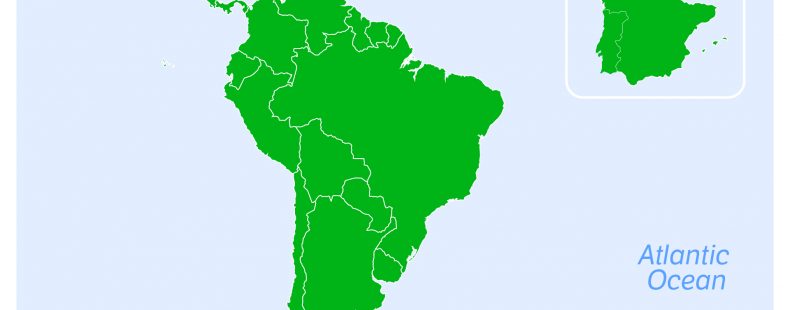Where in the world do people speak Spanish? If you sat down to make a list, you’d notice right away that the number of countries you can add to it is pretty substantial. Spanish is one of the most prevalent languages in the world, as it’s spoken not only in Spain and Mexico but also throughout North, Central, and South America and the African continent.
So, exactly how many Spanish-speaking countries are there? And where is Spanish the official language? Come along as we break down those facts and more about one of the world’s most popular languages.
Where did Spanish originate?
Spanish originated on the Iberian Peninsula, the section of land at the southwest corner of Europe that’s home to Spain and Portugal. The specific dialect of Spanish that first developed in Spain is also called Castilian, and it evolved as a continuation of Vulgar Latin mixed with Arabic from the Moors who once conquered parts of the region.
Spanish is one of the Romance languages, a group of languages that all developed around the same historical time period and as offshoots of Vulgar Latin. The family of romance languages also includes French, Italian, Romanian, and Portuguese.
As Spanish has spread throughout the world, several different dialects have developed. For example, Caribbean Spanish is characterized by omitted final consonants and an aspirated -r sound. Meanwhile, Argentinian Spanish is spoken with an intonation that’s similar to Italian. Spanish is as diverse as the millions of people who speak it.
What is an official language?
Spanish is spoken by nearly 500 million people worldwide, but just because a lot of people in a given country speak a particular language doesn’t mean it’s that country’s official language.
Official means “authorized or issued authoritatively.” So, an official language is usually one that has legal status in a particular state or country, like a legislative declaration recognizing it as the national language. This is the case for Spanish in countries like Argentina or Honduras.
But there are plenty of countries where a large number of people speak Spanish, yet it’s not the official language. The United States is a good example. The US is home to more than 41 million Spanish speakers, according to the US Census Bureau, but the country doesn’t have a designated official language. Instead, Spanish is one of several predominant languages spoken in the US, meaning it’s prominent and used by a large number of people.
So, where is Spanish an official language?
There are 20 countries where Spanish is the official language. They include:
- Argentina
- Bolivia
- Chile
- Colombia
- Costa Rica
- Cuba
- Dominican Republic
- Ecuador
- El Salvador
- Guatemala
- Honduras
- Mexico
- Nicaragua
- Panama
- Paraguay
- Peru
- Uruguay
- Venezuela
- Spain
- Equatorial Guinea
You might notice that some countries you assumed are Spanish-speaking are missing from this list. Why is that? Allow us to explain.
The confusion over official Spanish-speaking countries
If you’ve ever tried to pin down the exact number of Spanish-speaking countries in the world, you might notice the lists vary depending on which source you choose. Some lists say 23, while others might say 19, 20, or 21. There are a few reasons why this question can be complicated to answer.
First, it’s really easy to confuse official and predominant languages.
Sometimes people assume Spanish is the official language in a particular place, when it actually isn’t. In Belize, about 56.6% of the population speaks Spanish, according to the 2010 census. Given that it’s located in Central America and has a large Spanish-speaking population, it’s easy to assume Spanish is the official language—but it isn’t. English is actually the official language of Belize.
In addition to the US and Belize, other places where Spanish is predominant but not official include Andorra, Curacao, The Virgin Islands, Aruba, and Trinidad and Tobago.
Second, some countries have more than one official language.
Spanish is often cited as the official language of Mexico. But, while it’s true that more than 90% of Mexican residents can speak Spanish, Mexico actually has 69 recognized official languages, including Nahuatl, Maya, and other Indigenous languages. Some official language lists may include Mexico since Spanish is one of the official languages, but others may leave it off since Spanish is not the only official language.
Lastly, some Spanish speaking nations are also territories.
Spanish is the official language of Puerto Rico and a predominant language throughout Gibraltar and Western Sahara; however, these places are recognized as unincorporated territories of the US and the UK, so they frequently are not listed as independent Spanish-speaking nations.
Spanish is a complex and diverse language that gains more speakers every day. You can easily find people who speak Spanish in several parts of the world, and the language continues to evolve. In the future, it’s not hard to imagine that the official list of Spanish-speaking countries will get longer and longer.













